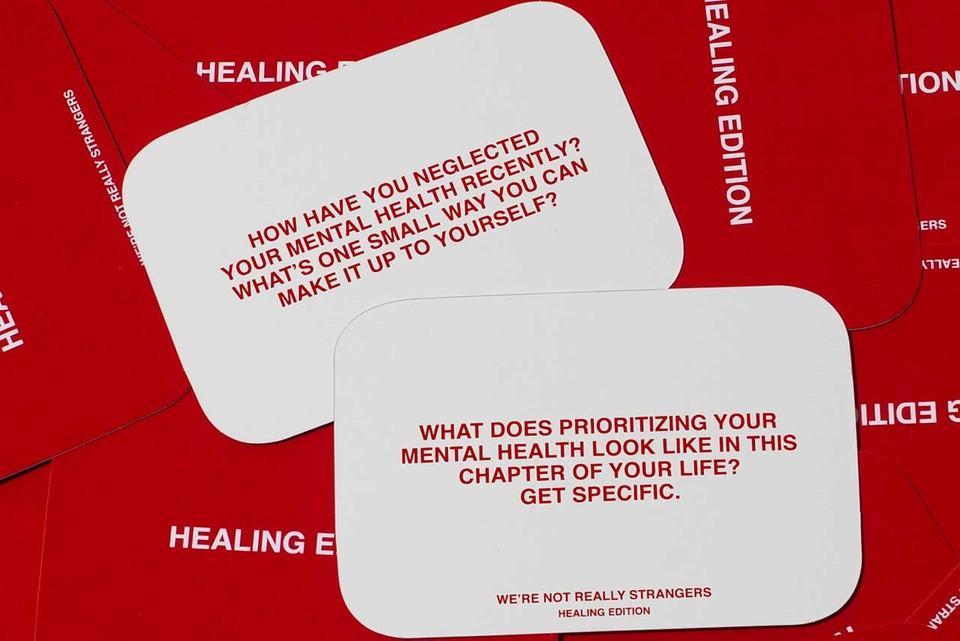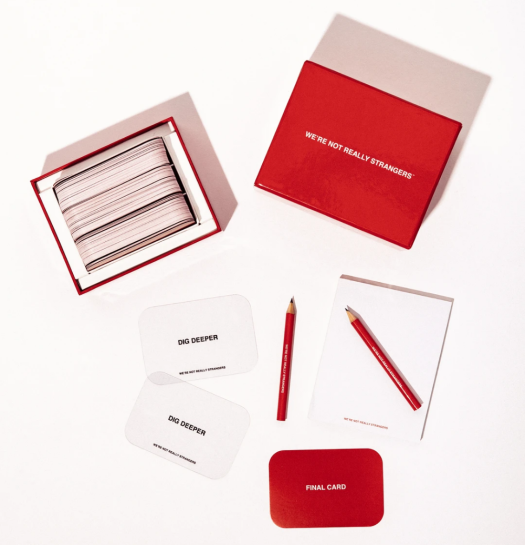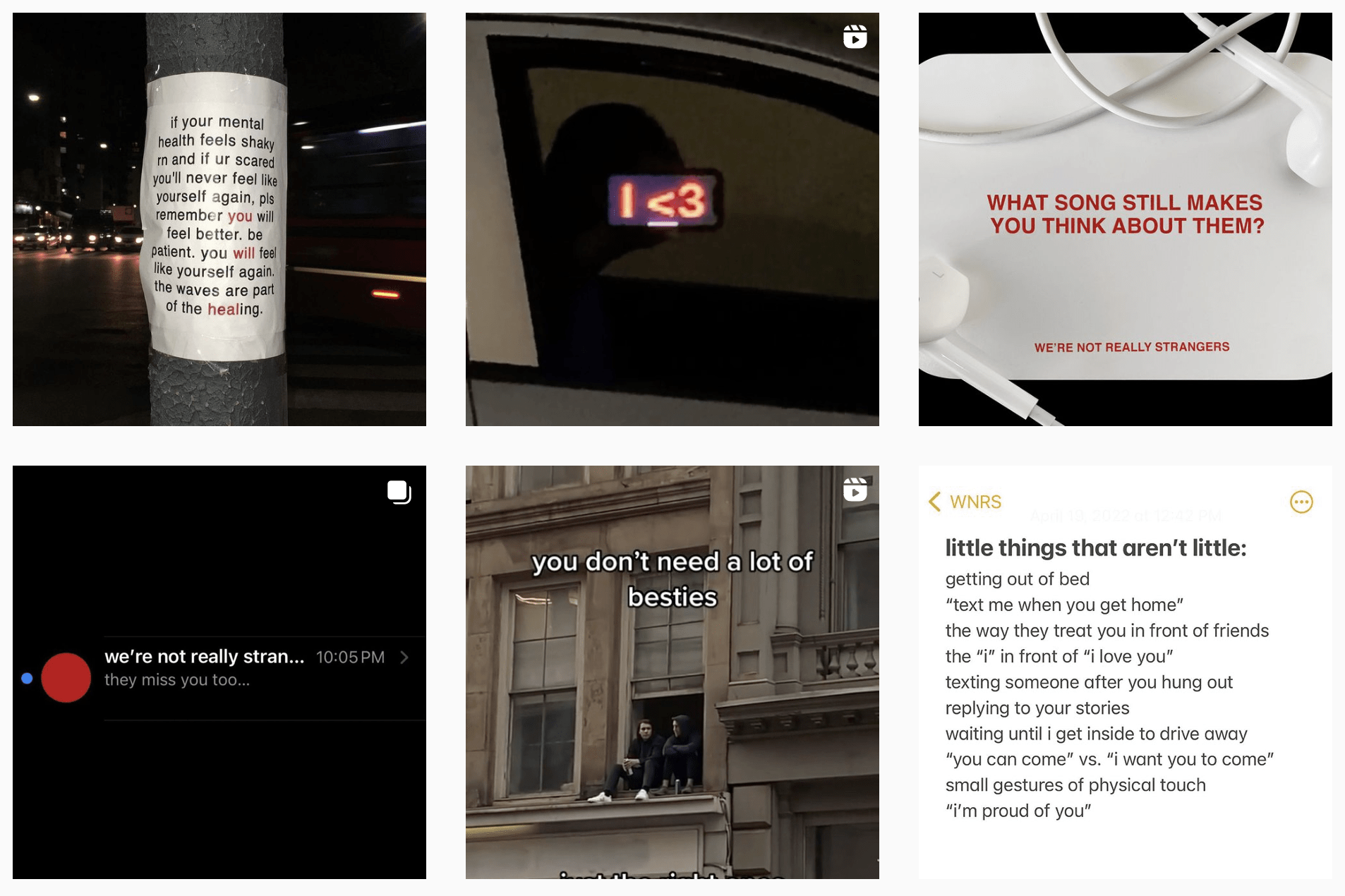I played We’re Not Really Strangers for this critical play, an analog getting to know you game (with options for digital expansion packs) created by photojournalist and model Koreen Odiney. We’re Not Really Strangers, touching on themes of vulnerability without a competitive element, is a fellowship game in its fullest form.
In terms of game mechanics, for a game with two people, the game comes with two transparent “Dig Deeper” cards, and includes three separate decks of cards representing three levels of questions players can ask one another (level 1 is perception, level 2 is connection, and level 3 is reflection). To determine who draws a card first, players stare at one another until someone blinks, and the person who blinks last goes first. Players start by drawing questions from the level 1 deck, where player A reads a question from a card to player B, and player B answers the question. Player B and player A then switch roles, continuing to draw questions from the level 1 deck until they have drawn at least 15 cards, and both players feel ready to move to the level 2 deck, draw at least 15 cards, and then move on to the level 3 deck. On each level, players can use their “Dig Deeper” card once, when they feel the other player can dig deeper to answer a question, meaning that a player should be more vulnerable. Wild cards are strewn throughout the deck to prompt players to complete tasks like “Close your eyes. Ask the other player to ask your eye color.”
For games with 3-6 people, the game comes with the same materials, except there is only one transparent “Dig Deeper” card. To determine who goes first, players write their first impressions in 3 sentences or less for each player in the group, fold their notes, exchange their notes among the group, and wait until the end of the game to read their first impressions out loud to one another. Rather than have player A read a question to player B, player A instead reads a question aloud to the entire group, and the entire group takes turns answering the question. Instead of drawing at least 15 cards per level, the multiplayer edition of We’re Not Really Strangers has players draw at least 2 cards per level, with the “Dig Deeper” card used once per level.
Most interesting about the game is its marketing, with creator Koreen Odiney primarily targeting Instagram users, and the Instagram account for We’re Not Really Strangers currently boasting 4.9 million followers. The game’s box, simple text on red, reflects the game’s content and core values, which are conversation and conenction. During 2020, We’re Not Really Strangers indicated the trend of marketing toward values, authenticity, and meaningful connection between brands and consumers. Luxury brands like Coach and Valentino have partnered with We’re Not Really Strangers to create billboards and street signs focusing on empathy. Its primary players are those who use Instagram, which targets primarily women between 25-34 years old.
I played with one other friend, and we spent at least an hour talking through the card prompts, playing through all three levels.
Questions we encountered:
- Do you find that you fall in love easily?
- How would you describe the feeling of being in love with one word?
- What’s the most pain you’ve ever been in that wasn’t physical?
- What was the moment you realized you weren’t invincible?
- What about me most surprised you?
We found that the game was fun and compelling because of the nature of the questions. The three levels of questions allowed players to ease into conversation and connection with one another. Additionally, the open-ended nature of the questions allowed players to shift the conversation’s tone from humorous to vulnerable. We’re Not Really Strangers explicitly, through “Dig Deeper” cards, forcing eye contact and personal notes between players, encourages players to be vulnerable with one another, to focus on answering questions authentically and honestly, and to bring their most vulnerable selves to the table. To finish off the game, my friend and I had to share a personal note with one another. Compared to other getting to know you games, like Two Truths and a Lie, the game’s prompts, marketing, and aesthetic cultivate a very specific emotional experience that focuses on vulnerability rather than superficial icebreaker questions.
I wonder, though, if the game could open itself up to more humor and wit in the questions it asks of players, tonally including packs with different colors dependent on emotional intensity, with options for players to opt out of harder-to-answer questions. The “Dig Deeper” cards felt uncomfortable to use, often forcing more vulnerability out of players than they wanted, like when my friend and I opened up a discussion around sexuality.





